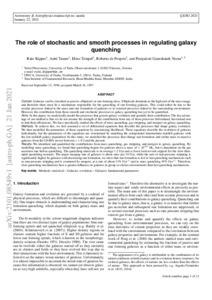The role of stochastic and smooth processes in regulating galaxy quenching
Kipper Rain; Tamm Antti; Tempel Elmo; de Propris Roberto; Veena Punyakoti Ganeshaiah
The role of stochastic and smooth processes in regulating galaxy quenching
Kipper Rain
Tamm Antti
Tempel Elmo
de Propris Roberto
Veena Punyakoti Ganeshaiah
EDP SCIENCES S A
Julkaisun pysyvä osoite on:
https://urn.fi/URN:NBN:fi-fe2021042821342
https://urn.fi/URN:NBN:fi-fe2021042821342
Tiivistelmä
Context. Galaxies can be classified as passive ellipticals or star-forming discs. Ellipticals dominate at the high end of the mass range, and therefore there must be a mechanism responsible for the quenching of star-forming galaxies. This could either be due to the secular processes linked to the mass and star formation of galaxies or to external processes linked to the surrounding environment. However, the contribution from these smooth and stochastic processes to galaxy quenching has yet to be quantified.
Aims. In this paper, we analytically model the processes that govern galaxy evolution and quantify their contribution. The key advantage of our method is that we do not assume the strength of the contribution from any of these processes beforehand, but instead aim to find their efficiencies. We have specifically studied the effects of mass quenching, gas stripping, and mergers on galaxy quenching.
Methods. To achieve this, we first assumed a set of differential equations that describe the processes that shape galaxy evolution. We then modelled the parameters of these equations by maximising likelihood. These equations describe the evolution of galaxies individually, but the parameters of the equations are constrained by matching the extrapolated intermediate-redshift galaxies with the low-redshift galaxy population. In this study, we modelled the processes that change star formation and stellar mass in massive galaxies from the GAMA survey between z approximate to 0.4 and the present.
Results. We identified and quantified the contributions from mass quenching, gas stripping, and mergers to galaxy quenching. By modelling mass quenching, we found that quenching begins for galaxies above a mass of approximate to 10(10.2) M-circle dot, but is dependent on the gas accretion rate before quenching. The quenching timescale is on average 1.2 Gyr and a closer look reveals support for the slow-then-rapid quenching scenario. The major merging rate of galaxies is about once per 10 Gyr, while the rate of ram pressure stripping is significantly higher. In galaxies with decreasing star formation, we show that star formation is lost to fast quenching mechanisms such as ram pressure stripping and is countered by mergers, at a rate of about 41% Gyr(-1) and to mass quenching 49% Gyr(-1). Therefore, slow quenching mechanisms have a greater influence on galaxies in group or cluster environments than fast quenching mechanisms.
Kokoelmat
- Rinnakkaistallenteet [27094]
